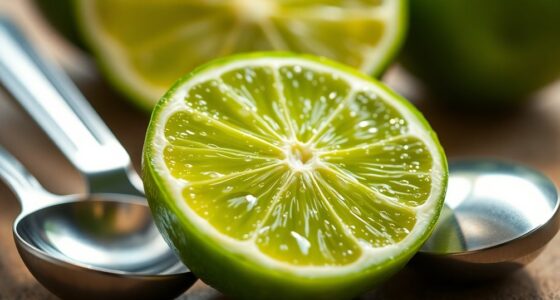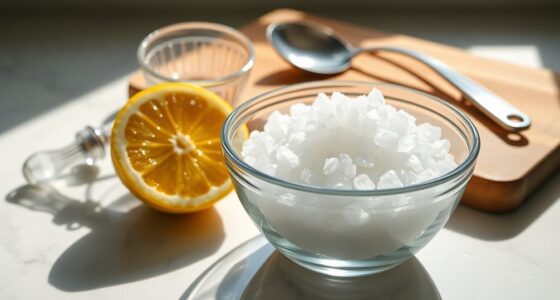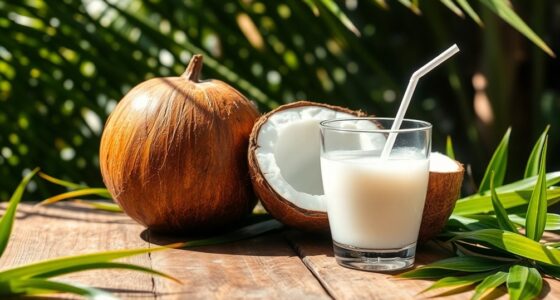Using tomato juice to get skunk smell out of your dog isn't effective. Instead, whip up a powerful mixture of 1 quart of 3% hydrogen peroxide, ¼ cup of baking soda, and 1 tablespoon of dish detergent. Apply this directly to dry fur—don't wet your dog first! Let it sit for five to ten minutes, rinse thoroughly, and follow up with a regular dog shampoo. There's more to know about keeping your pet odor-free!
Key Takeaways
- Tomato juice is a common myth for skunk odor removal, but it is ineffective against thiol compounds.
- The best method involves using a hydrogen peroxide mixture to break down skunk odor.
- Apply the solution directly to dry fur without pre-wetting the dog to avoid reactivating odors.
- Rinse thoroughly after allowing the solution to sit for five to ten minutes; follow with dog shampoo.
- Monitor your dog for skin irritation post-treatment and consult a vet if necessary.

If your dog has been sprayed by a skunk, you know how overwhelming that pungent odor can be. The smell can linger for days, making you feel desperate to remove it. You might've heard that tomato juice is a go-to remedy, but let's clear up that misconception right away. While it can mask the smell temporarily, it doesn't actually neutralize the skunk odor. The real culprit behind that awful scent is thiol compounds, which are sulfur-based and cling to your dog's fur, making them tough to remove without the right approach.
To effectively tackle the skunk smell, you need to act fast. The best method involves using a mixture of 1 quart of 3% hydrogen peroxide, ¼ cup of baking soda, and 1 tablespoon of dish detergent. This combination is specifically designed to break down those stubborn thiol compounds and can significantly help in removing skunk odor from your dog's coat. It's crucial to apply this solution immediately after your dog has been skunked. The longer you wait, the harder it will be to eliminate that smell.
Before you start, remember not to wet your dog beforehand. Wetting your skunked dog can reactivate those thiol compounds, making the odor even worse. Instead, you'll want to apply the hydrogen peroxide solution directly to your dog's dry fur. Make sure to work it into the coat thoroughly, focusing on the areas where the skunk spray hit the hardest. Be careful to avoid your dog's eyes and mouth; this solution can be irritating.
Once you've applied the mixture, allow it to sit for about five to ten minutes. This gives the ingredients time to work their magic and effectively break down the skunk odor. After that, rinse your dog thoroughly with warm water. It's important to remove all traces of the solution to ensure your pet's health and comfort.
Following the rinse, you'll want to give your dog a bath using a regular dog shampoo. This step helps to restore your dog's coat and eliminate any lingering scents.
After the bath, keep an eye on your dog for any signs of skin irritation. If you notice anything unusual, it's best to consult your veterinarian for advice on pet health. Remember, while the immediate odor removal is important, ensuring your dog's skin remains healthy is just as crucial.
Frequently Asked Questions
Does Tomato Juice Get Rid of Skunk Smell on Dogs?
Tomato juice doesn't effectively get rid of skunk smell on dogs. While it might mask the odor temporarily, it doesn't neutralize the thiols responsible for that pungent scent.
You might notice a reduction in smell, but it can return once the juice dries or washes off. Instead of relying on tomato juice, try a mixture of hydrogen peroxide, baking soda, and dish detergent for a more effective solution.
Will Tomato Juice Remove Skunk Smell?
Tomato juice won't effectively remove skunk smell.
While it might mask the odor temporarily, it doesn't neutralize the thiols responsible for that pungent scent.
You'll likely find that your dog ends up smelling like a mix of skunk and tomato soup after using it.
For a more effective solution, consider using a mixture of hydrogen peroxide and baking soda, which chemically alters the compounds causing the smell and provides better results.
What Neutralizes Skunk Odor on a Dog?
To neutralize skunk odor on your dog, you'll need a more effective solution than tomato juice.
A proven method involves mixing 1 quart of 3% hydrogen peroxide, ¼ cup of baking soda, and 1 tablespoon of dish detergent.
Apply this mixture directly to your dog's fur, avoiding the eyes.
Afterward, rinse thoroughly to remove all residues and restore your dog's normal scent.
This combination chemically alters the odor-causing compounds for better results.
Does Dawn Remove Skunk Smell From Dogs?
Dawn dish soap can help remove skunk smell from your dog, but it's not the most effective solution.
While it cuts through greasy residues, it won't completely neutralize the odor-causing compounds. You might find that it only masks the smell temporarily.
For better results, consider using a combination of Dawn with hydrogen peroxide and baking soda.
Just remember to follow up with a moisturizing dog shampoo to avoid drying out your dog's skin.
Conclusion
In conclusion, getting rid of that skunk smell from your dog might feel like an epic battle, but you can win with the right approach! Tomato juice works wonders, but don't forget to rinse thoroughly and follow up with a dog-friendly shampoo. Your furry friend will be back to their old self in no time, smelling fresh as a spring meadow. So roll up your sleeves and tackle that odorous challenge—your pup deserves it!
Cindy thoroughly researches juicing trends, techniques, and recipes to provide readers with practical advice and inspiration. Her writing style is accessible, engaging, and designed to make complex concepts easy to understand. Cindy’s dedication to promoting the advantages of juicing shines through her work, empowering readers to make positive changes in their lives through the simple act of juicing.

















